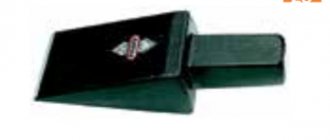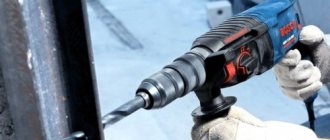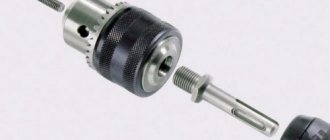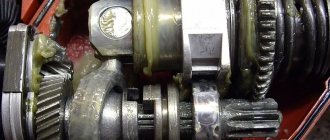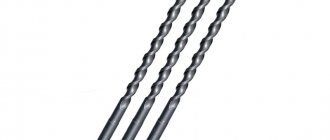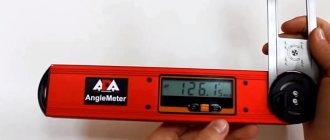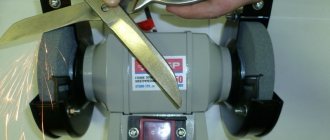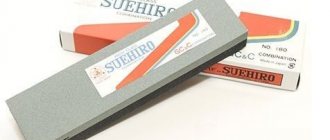- 1 Purpose
- 2 Types of chisels
- 3 What are concrete chisels made of?
- 4 Do I need to sharpen chisels for concrete?
- 5 Concrete chisels SDS-PLUS
- 6 Conclusion
It's time to do major renovations in your apartment, but you don't know what tools to buy? Do you want to wire new outlets and can't choose the right fixture? These tasks can be handled with a hammer drill. A large assortment of chisels and drilling elements will make the task easier, since making a hole for a wire or communications manually or knocking out tiles in the bathroom is, at a minimum, labor-intensive. Today we will look at what chisels exist and what to do with them.
Purpose
Making home repairs without using a hammer drill is much more difficult. A hammer drill is a tool whose purpose is to process stone or metal surfaces. It is used to knock off old finishes, punch holes for wires, etc. To do this, he needs to choose the right chisel for concrete. This is a metal-cutting device for stone and metal, which looks like a long cylindrical rod.
It consists of two parts:
- working cutting edge (cuts the base);
- butt plate - the final part that is attached to the hammer drill.
A hammer drill chisel has many differences from a mechanic's chisel. One end is adapted to attach the chisel to the hammer drill. For small devices (up to 5 kg), an SDS shank is used, which is used for working with concrete, reinforced concrete, and other bases that are difficult to process; for medium ones (5-12 kg) - SDS-max, for large ones (more than 12 kg) use the HEX mount, which consists of six edges.
A metal chisel is a device with a rectangular cross-section, which is equipped with four cutting edges.
Return to contents
Selection of equipment for wall gating
The hammer drill itself is considered a fairly powerful power tool, as it can be used as three tools, namely a drill, a screwdriver and a jackhammer.
The use of a hammer drill greatly facilitates and speeds up both installation and dismantling work. Its use is considered the cleanest and fastest process compared to using an angle grinder or wall chaser. In addition, when purchasing a hammer drill, you need to opt for a three-mode hammer drill, which, in addition to the drill and impact drilling modes, has a jackhammer mode. If you use different attachments, the process will not be so complicated. The main disadvantage is increased dust formation, but when using an angle grinder there is much more dust.
In order to correctly decide which hammer drill to choose and what kind of attachment is needed for this work, you need to know what material the walls are made of and what kind of work will be carried out. The type of attachments you need to purchase and the power of the hammer drill depend on this. The device must have a power of at least 800 watts. If possible, it is better to rent a tool.
Hammer with a nozzle for cutting a peak Hammer with an attachment for gating a crown
Of course, you need to choose a brand of hammer drill. If you look at the reviews, the most recommended ones are BOSH, Zubr, and SDS Max. Makita, although a Japanese technique, has an average impact force, although there are good reviews about it. But if the concrete is of high quality, then the work will not work at all.
To make holes with a crown, you need a more powerful tool. You can use such a tool, but with transitions from a smaller diameter to a larger one with small gaps in diameter. Then a powerful tool is not required and money is saved. But it’s still better to choose one with an impact force of 3-5 J. It is imperative to take into account the idle speed.
Types of chisels
Bosch SDS-plus lance chisel.
The shape of the tool used varies depending on how and where it will be used. Chisels are mainly classified according to their shape:
- Pike - looks like a cone or pyramid with a sharp end. With its help, holes are punched in a brick or concrete base (if there is no crown), and old building materials are removed. Excellent for working with reinforced concrete. It leaves jagged edges, so its use is not recommended.
- Spatula - looks like a curved screwdriver, the cutting edge is wide and thin. Using such a chisel, old finishing material (for example, plaster) or old asphalt are removed. May look like a garden spatula.
- Flat – looks like a screwdriver with a pointed tip. This is the most common and oldest type. The cutting edge varies between 1-4 cm. The smaller the value, the greater the effort required when working.
- A special shape (strober) is a semicircular blade that has a curved shape. Use a chisel to pierce wall channels for wiring. These tools have wings lengthwise, which makes work more convenient. These wings rest on the wall to adjust the depth. The edges of the hole remain smooth after finishing work. The diameter of the tool can vary, so they are suitable for both punching holes for wires and laying pipes. Such a chisel can be not only U-shaped, but also another one, for example, a blade curved upward, which is used to remove old seams in brickwork.
Return to contents
Basic rules for carrying out work
Most importantly, when starting work, you need to know the basic rules for gating walls.
If this is an apartment building, such work on cutting grooves in load-bearing walls is prohibited. This is especially true for panel houses. In the process, the reinforcement is exposed and becomes corroded, which weakens the structure of the entire house. In a brick house, during this work you should use an ordinary metal detector. It is also prohibited to cut ceilings in apartment buildings.
It is best to have an apartment plan indicating load-bearing walls or consult with a BTI specialist. There is a document that would be a good idea to read before starting work. This is SNiP 3.05.06-85. It specifies the rules for the distribution of wires in the walls. It’s better not to be lazy, but to read it so that no incidents happen during the gating. It must also be remembered that the depth and width of the groove after work should not exceed 2.5 mm, and the length 3 m. The distance from doorways should be at least 100 mm, and from gas pipes 400 mm.
Slotting scheme
You also need to know the location of the old electrical wiring so that you can bypass it and lay grooves without touching it. It may make sense to de-energize the old wiring. Be sure to have voltage indicators with you. After punching the grooves, the wires begin to be laid. They can be laid in two ways - either by laying them in a pipe or by fixing them in the channel with plaster. The holes for the socket are made in blocks, that is, everything is placed in one unit: sockets, connectors for the telephone, the Internet, etc.
What are concrete chisels made of?
Most often, chisels are made of forged steel.
Chisels are most often made of forged steel (chrome vanadium, chrome molybdenum). The material has sufficient strength, which ensures efficient operation. The device is hardened at a temperature of 750-8000. In artisanal conditions, it depends on what grade of steel is used, for example, 730-9500 is suitable for low-carbon steel.
Warm up the device evenly, without temperature jumps, so that there is no jump between the working and internal parts. After this, it must be placed in the oven. This technology will have a better effect on steel than rapid heating. After heating, it must be cooled sharply with water or oil. There should be a lot of liquid.
To obtain maximum strength, the metal must first be cooled slowly, and from 650 to 400 degrees - quickly. There is no need to be afraid that the liquid begins to evaporate and as a result the metal is not in it, but as if enveloped in steam. This is a normal course of the process. It provides slow cooling. When the chisel is less hot, this cocoon will disappear and it will quickly become colder.
It is necessary to place the device in water perpendicular to the surface and slowly, with the cutting edge down, after which it is necessary to turn it in different directions to avoid a sharp temperature change and reduce the cocoon. This technique will help harden the edges and leave the core dynamic.
Return to contents
Sharpening rules
The sharpened edge makes it easier to work with durable materials and extends the life of the nozzle. It is recommended to sharpen the working surface on a sharpening machine or angle grinder with an abrasive wheel at medium speed. It must be rotated on all sides to achieve uniform sharpening and avoid burrs. Overheating above 1000 °C should not be allowed; for cooling, the products can be immersed in chilled water.
Purchased rotary hammer blades are produced already sharpened at the factory. The angle of the cutting edge depends on the purpose of use. A sharp blade is recommended for working with brittle and soft materials (aluminum, zinc, copper, bitumen film). If you plan to crush concrete, then sharpening may not be necessary. Experienced builders recommend having two nozzles with different sharpnesses at once - for rough and fine work.
Important! The sharpening angle can vary from 35 to 70° depending on the purpose and material of the surface being pierced.
A spatula is an attachment for a home or professional hammer drill. It can be used to dismantle a wall, make a hole for electrical wiring, or remove seams in brickwork. When choosing a specific model, you should take into account the application tasks, the type of hammer drill chuck, the sharpening angle and other design features.
Do you need to sharpen chisels for concrete?
The sharpening angle of the chisel depends on where the tool will be used. The sharpness of the sharpening angle does not mean its good performance. Such a chisel quickly becomes dull. Therefore, it is necessary to make an angle of medium sharpness (for fragile bases, for example, cast iron, bronze - 700; for medium platforms - 600; for soft materials, for example, copper -450, for aluminum and zinc - 350).
The chisels of concrete hammer drills rarely need to be sharpened thanks to the long life technology, the essence of which is that the blade is sharpened during operation. If the chisel is sharpened well and at the right angle, it will work effectively with any base.
It is necessary to sharpen the tool with a supply of cold liquid, but it can also be done without. In this case, it is necessary to ensure that its temperature does not rise above 1100, since if it is higher, the strength and hardness of the tool decreases.
As a result of sharpening, the angles and width of the chisel should be uniform on all sides. Therefore, when sharpening, it is necessary to evenly turn the chisel in different directions, working a little in each direction. When the work is completed, the blade and shank are chamfered and the shape of a truncated cone is made. Dust from such work is harmful to health.
Return to contents
Rules for sharpening a rotary hammer blade
Sharpening is a process that creates the main property of a chisel. It is performed at a manufacturing plant or at home (much less often).
High-quality blades are already produced sharpened. In this case, you can pay attention to the correspondence of the angle to the scope of application:
- 35-45 degrees – soft metals;
- 60 degrees – medium strength materials;
- 70 degrees or more – fragile materials.
If the hardness of the material does not match the angle, the working edge will quickly become dull. To avoid spontaneous reduction in pungency, metallurgical and chemical processing methods are used.
At home, sharpening can be done using a sharpening machine. The following must be taken into account:
- During the process of removing the metal layer, flying chips are formed - respiratory and visual protective equipment should be used;
- Removal of the layer must be carried out evenly and by turning the nozzle;
- heating of the blade should not exceed 1100 degrees (visually dark yellow color).
It is best to request such an operation from specialists - they know what to do. An inexperienced master can worsen the blade and, as a result, reduce labor productivity.
Concrete chisels SDS-PLUS
Drills and chisels SDS plus (SDS+).
Such tools are used as attachments for the light or medium SDS-PLUS hammer drill. They are made of thermal steel. Their long wear resistance is ensured by special processing and hardening methods. Shot blasting provides bonus protection. Pobedit soldering also adds to its strength.
Such tools are used to chisel concrete, masonry or natural stone with rotary hammers. SDS-PLUS is a cartridge for:
- groove (groove cutter) - used to chisel grooves in masonry;
- a flat (shovel) tool used for chiseling concrete, masonry or natural stone;
- peak - for laying electrical networks, tearing off tiles, etc.
The tool can be made of a material that can still be sharpened or with a carbide insert in the edge.
Return to contents
Types of nozzles for gating
Well, we got acquainted with the basic rules, the drawing and plan were drawn up. It is advisable to take a photo of the markings so that you don’t have to look for the wiring later. Now let's decide on the nozzles. Basically this is a drill and a shovel for laying cables and a crown for openings for a socket. Please note that this type of work will generate a lot of dust, so doorways should be covered tightly with a damp cloth. During work, you need to use a special construction vacuum cleaner to clean the air and room from concrete dust. An ordinary vacuum cleaner will quickly fail.
You need to start work by drilling holes for sockets and mounting boxes using a drill and a hole saw of the required size.
Grooving principle
To start making a recess for the sockets, use a bayonet punch attachment, then a spatula, then a crown. The crown is usually used with an extension. This nozzle has the shape of a cylinder with cutting teeth. It is secured in the chuck using a shank. You can also use this method: use a hammer drill to drill a hole of about 10 mm with pressure, then use a crown to expand it and deepen it. We use a crown of the required size for holes for mounting boxes, where you can hide both electrical connectors, for the Internet and telephone, and under sockets.
Manufacturing of block channels
